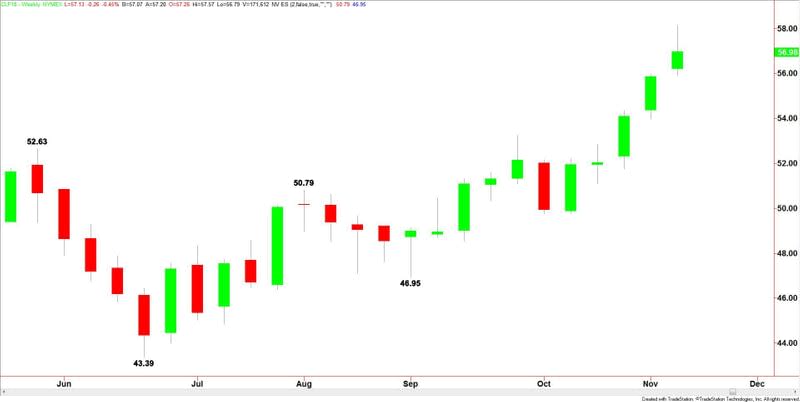Oil Price Fundamental Weekly Forecast – May Be Topping; Increased Volatility Expected
U.S. West Texas Intermediate and Brent crude oil futures closed higher last week despite a few warnings signs on the daily chart suggesting a short-term top may be forming.
January WTI Crude Oil futures settled at $56.98, up $1.12 or +2.01% and February Brent crude oil ended the week at $63.41, up $1.61 or +2.61%.

The week began with crude oil futures underpinned by expectations that the OPEC-led agreement to cut production would be extended beyond the March 2018 deadline. This event has been driving the market higher for several weeks.
Concerns that the market was overbought were eased a bit early last week when prices surged to the upside due to geopolitical events in the Middle East. Major arrests in Saudi Arabia due to a crackdown on corruption and an escalation of tensions between Saudi Arabia and Iran helped drive prices to nearly a two-year high.
These events contributed to the first shot of increased volatility. The second phase was generated by a mixed government inventories report.
According to the U.S. Energy Information Administration, U.S. crude oil stockpiles rose unexpectedly during the week-ending November 3. The move was fueled by a jump in imports and a plunge in exports. U.S. production also hit its highest level since at least 1983.
Crude inventories rose 2.2 million barrels versus estimates for a 2.9 million barrel draw down. Gasoline and distillate inventories fell to multi-year lows, even as refining rates rose.
The EIA also said domestic crude production rose 67,000 barrels per day to 9.62 million bpd.
The crude oil portion of the EIA report was bearish, but the product components were bullish.
In other news, oil services firm Baker Hughes reported U.S. drillers added 9 rigs, bringing the total up to 738.

Forecast
Traders will be facing a huge dilemma this week. They are going to have to decide whether to continue to buy strength in anticipation of an extension of production cuts, or wait for a pullback into a value area in reaction to rising U.S. production. These are the issues that could cause the next wave of volatility.
Furthermore, an escalation of tensions in the Middle East could trigger a surge to the upside, while the increase in the number of producing oil wells in the U.S. could drive prices sharply lower, for example.
This article was originally posted on FX Empire
More From FXEMPIRE:
US Dollar Index (DX) Futures Technical Analysis – Trend Changes to Down Under 94.115
USD/JPY Fundamental Daily Forecast – U.S. Bank Holiday May Have Prevented Further Weakness
S&P 500 Price forecast for the week of November 13, 2017, Technical Analysis
Crude Oil Price forecast for the week of November 13, 2017, Technical Analysis
Oil Price Fundamental Weekly Forecast – May Be Topping; Increased Volatility Expected
